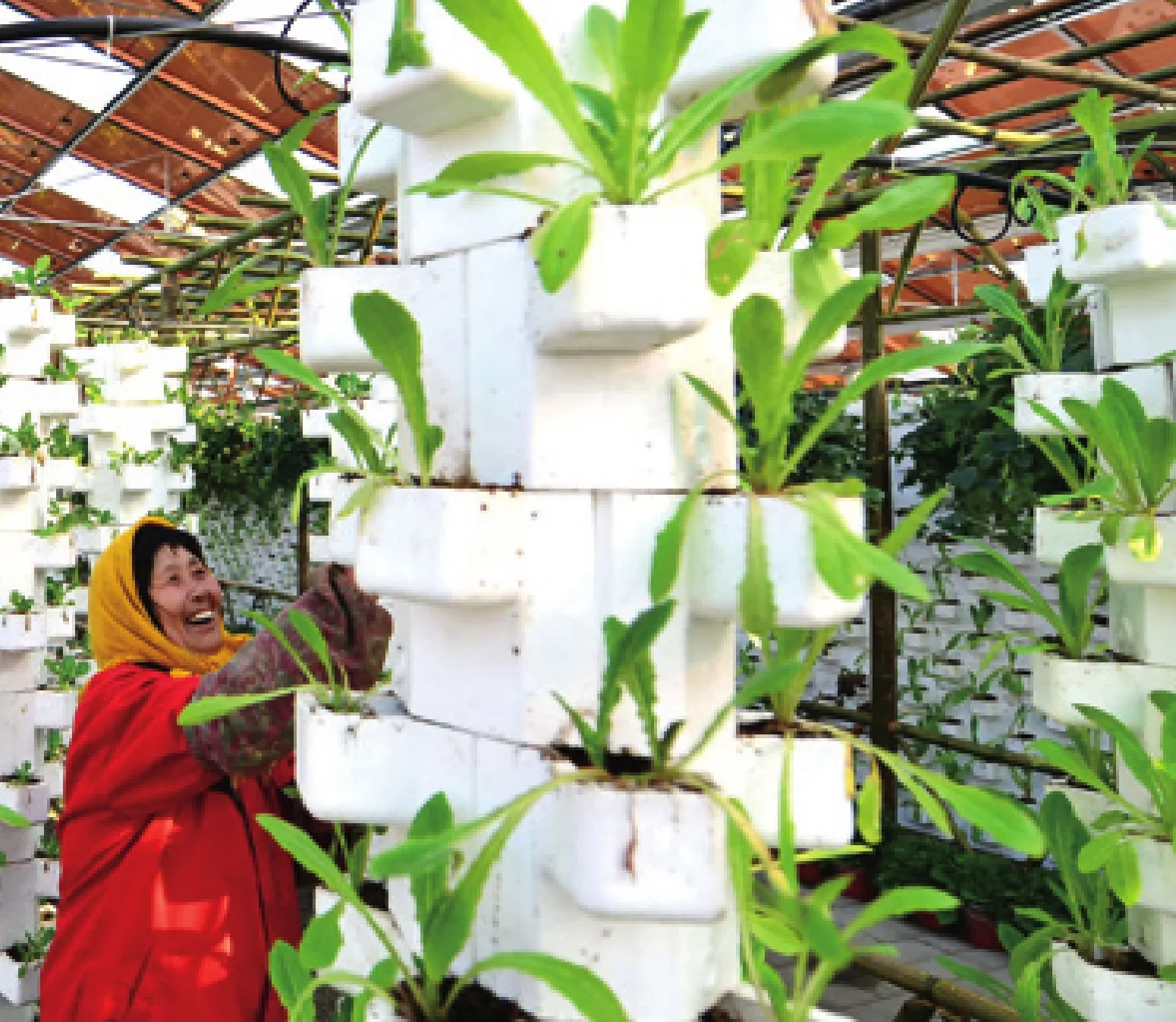Avoiding the Trap
2013-12-07ByYinpumin
By Yin pumin
A fairer distribution of wealth could spring China from the jaws of the middle-income trap
In late February, the National Bureau of Statistics (NBS) published its annual statistical bulletin, showing that China’s gross domestic product (GDP) registered an increase of 7.8 percent in 2012, reaching 51.93 trillion yuan ($8.33 trillion).
With the Chinese population expanding to 1.3 billion, NBS figures show that the country’s per-capita GDP reached $6,100 last year, leaving China within the rank of middle-income countries by World Bank standards.
According to 2008 World Bank standards,countries should have a per-capita GDP above$11,906 to be part of a high-income group of countries, while $3,856 is the minimum level for middle-income countries. In 2011, the World Bank raised the standards to $12,475 and$4,036 respectively.
NBS figures showed that China became a middle-income country in 2010, when its percapita GDP reached roughly $4,300, triggering debate over whether the country is heading into the “middle-income trap.”
As labor and other costs continue to rise,some fear that China will slip into a dilemma between losing its competitive edge over lowercost countries elsewhere and falling behind advanced economies in higher-value products,and fall into the same trap as those middleincome economies experienced in the past.
If China wants to avoid the trap, it needs to undertake a slew of reforms, such as investing in technology, promoting innovation in the private sector, speeding up urbanization and reducing income inequality so that ordinary people benefit more from economic growth,the Asian Development Bank (ADB) said in a report published last October.
“Tilting the balance of the economy from low-cost to high-value production, from relying on government to relying on markets, from investment to consumption, and from external to domestic demand will allow China to grow beyond its current middle-income status,” said Zhuang Juzhong, the report’s co-author and ADB deputy chief economist.
“Implementing this strategy would greatly increase the likelihood of sustained growth and reaching high-income status before 2030,” the ADB said in the report. “Scenario analysis shows China has the potential to grow 8 percent annually from 2010 to 2020 and 6 percent from 2020 to 2030, if it addresses its challenges effectively.”
Advancing reforms
In the more than 30 years since the reform and opening-up policies were introduced, China has witnessed rapid development. According toADB statistics, the Chinese economy achieved an average annual growth rate of 9.9 percent from 1980 to 2011.

CONSUMPTION BOOST: Shanghai residents browse housewares at a local supermarket.Economists say China needs stronger consumer spending to sustain growth
However, behind that rapid development were low-cost labor and low-quality exports. For today’s China, the development model has reached its limits, according to Robert Wihtol, Director General for ADB’s East Asia Department.
Middle-Income Trap
The concept of middle-income trap was first put forward by the World Bank in 2006. It refers to the economic phenomenon of a country reaching the middle-income stage,then being incapable of completing an economic transformation to become a highincome country , due to problems such as an unbalanced industrial structure and lack of policy innovation.
According to statistics by the World Bank,eight major Latin American economies, including Argentina and Brazil, were caught in the trap when they tried to shift their growth model from low wages to high skills, a step that is critical to evolve into higher-income economies.
Only 13 of 101 countries and regions that entered the middle-income stage in the 1960s had escaped the middle-income trap by 2008, World Bank figures show.
He said that China is losing its advantage to compete with low-income countries due to sharp rising wages and other production costs on the one hand; on the other, it cannot compete with developed economies either because of its relatively low level of technology and innovation.
“China is not a cheap place any longer,”said Zhang Yansheng, Director of the Institute for International Economic Research under the National Development and Reform Commission(NDRC). “The country is quickly losing its traditional advantages, while its new advantages have yet to take their place.”
Zhang warned that the country’s laborintensive, export-reliant and investment-driven economy is unsustainable, and China must upgrade its industrial structure and strengthen its innovation capabilities.
“Without changing the development model, China will find it difficult to sustain its growth and avoid the middle-income trap,” Zhang said.
According to Zhang Chewei, Deputy Director of the Institute of Population and Labor Economics of the Chinese Academy of Social Sciences, as labor costs rise and the aging population continues to grow, China’s demographic dividend, the window of opportunity for a country’s economic growth, will completely disappear by 2025.
“For the economy to take off, China must strive to complete its economic restructuring before that time, otherwise, it can only be stopped halfway, falling into the middle-income trap,” Zhang said.
“The case for reform is compelling because China has now reached a turning point in its development path. Managing the transition from a middle-income to a high-income country will prove challenging,” said former World Bank President Robert B. Zoellick.
Li Yining, a renowned Chinese economist and Dean Emeritus of the Guanghua School of Management of Peking University, said that China needs to promote economic reforms that cross into “uncharted waters.”
“With the transformation of China’s growth pattern, the country’s efforts to boost consumer spending and reform income distribution will be further pushed forward, and these will act as the driving force for national economic development,” said Zheng Xinli, vice Chairman of the China Center for International Economic Exchanges, a government think tank.
If economic reform is properly carried out, China will be capable of maintaining an 8-percent growth in GDP for another 20 years,he predicted.
“Agricultural modernization is the key driving force for China to escape the middleincome trap,” Zheng said.
As a consequence of China’s agricultural modernization process and its accelerated efforts to transform the sector from a longestablished extensive to an intensive model,more rural workers will be transferred into urban areas, which means that the labor force will shift from the agriculture to the industrial and service sectors, Zheng said.
In 2012, the output of China’s agricultural sector was about 10 percent of the national GDP, while farmers accounted for 36 percent of the national labor force, research by Zheng’s think tank showed.
“The low productivity of the agricultural sector is the main reason for the broad income gap between rural and urban residents,” he said.
The Central Committee of the Communist Party of China (CPC) and the State Council,China’s cabinet, released a document on January 31 pledging to accelerate agricultural modernization through the establishment of large family farms and measures to improve intensive production.
“The move requires setting up a system to ensure the effective supply of important agricultural products, increase farmers’ income and improve their livelihoods, as well as push forward reforms in rural areas,” the document said.
“One of the most urgent things is to remove restrictions on investing in the agricultural sector,” said Zheng, citing greater capital requirements in development of large modern farms and purchasing mechanical equipment.
According to Liu Yonghao, Chairman of the New Hope Group, one of the largest suppliers of meat, egg and dairy products in China, the government should reform the financial system to support the development of family farms.
“Belonging to small and medium-sized enterprises (SMEs), family farms are facing more difficulties than larger enterprises in fundraising,” Liu said.
In order to better support SMEs, it is a must to adopt interest-rate liberalization and allow private capital to set up financial institutions, according to Zheng.
“Liberalizing the financial sector will also improve the allocation of capital in support of the transition to an innovation-based economy while lowering the cost of, and improving access to, finance,” Zheng said.
Zhang Yongjun, a research fellow at the China Center for International Economic Exchanges, calls for greater efforts to help rural workers settle in cities.
A study by the Academy of Macroeconomic Research of the NDRC shows that high-income countries should meet three conditions: Urban residents should be more than 70 percent of the population; the agricultural sector’s labor productivity should be close to those of industrial and services sectors; and rural residents’income should be close to or more than that of urban residents.
“Policies should be improved to include migrant rural workers in urban social security systems,and to provide them with employment opportunities,” Zhang Yongjun said. “So the promotion of agricultural modernization should be in line with the process of urbanization and industrialization.”

MODERN LIFE: Yu Xiuxiang, a farmer in Jimo City in east China’s Shandong Province, tends to vegetables in a solar cellpowered greenhouse on March 14
Addressing inequality
At a press conference during the full session of the 12th National Committee of the Chinese People’s Political Consultative Conference(CPPCC) in March, Li of the Peking University said that if China wants to avoid the middleincome trap, it has to reform its income distribution system.
Three decades of fast growth have exacerbated the gap between high- and low-income groups, and between cities and rural areas.“Growing income disparity and social disorder are the major causes of the middle-income trap,” the economist said.
According to NBS statistics, China’s Gini coef ficient, a widely used measure of economic inequality, reached 0.474 in 2012. An index reading between 0.3 and 0.4 means the richpoor gap is relatively reasonable, according to UN standards.
“The statistics highlight the need for China to speed up income distribution reforms to narrow the wealth gap,” said Ma Jiantang, commissioner of the NBS.

COLORFUL CONTAINERS:The East China Import &Export Fair exhibits jugs emblazoned with animal cartoons. Exports drove much of China’s economic growth over the past few decades
According to Ma, the average income of urban residents in China is about three times that of rural people. While in urban areas, the average income of high-income group is about four times that of the low-income group.
The average per-capita disposable income of urban residents in 2012 was 24,565 yuan($3,943), while the average per-capita net income of rural residents was 7,917 yuan ($1,271),with the income ratio reaching 3 to 1, according to the NBS.
After dividing the urban residents into five groups according to their incomes, the average income of the highest-earning group reached 51,456 yuan ($8,259), almost five times that of the lowest-earning group with an average income of 10,354 yuan ($1,662).
“China’s Gini coefficient is relatively high compared with the warning level of 0.4, reflecting the severity of the yawning wealth gap,” said Wang Jun, an economist at the China Center for International Economic Exchanges.
“High inequality will hinder future growth,as low-income households contribute little to demand and are unable to invest in skill training and development,” said Zhuang. Beyond direct economic impacts, inequality has the potential to generate social instability, the ADB economist added.
To address the problem, China has vowed to double the country’s 2010 GDP and per-capita income for both urban and rural residents by 2020, according to the 18th CPC National Congress in November last year.
It is the first time that China has detailed its objective on per-capita income, an internationally accepted indicator for gauging people’s living standards, in the country’s blueprint for future development. Targets set at the 16th and 17th CPC national congresses back in 2002 and 2007 respectively merely called for more GDP growth.
But Ma said that only doubling the GDP and per-capita income is not enough. “China should make endeavors to better distribute the cake of its economic growth while trying to make it bigger, and strive to make the incomes of low- and middle-income residents grow faster,” he said.
To this end, an improved tax system has been proposed as a solution. According to experts, a well-designed tax system assists in wealth redistribution by transferring resources from the rich to the needy.
Gan Li, Director of the Economics Department at the Southwestern University of Finance and Economics in Chengdu, Sichuan Province, said that the Gini coefficient is remarkably lower in developed economies with a mature tax system.
“In China, taxation has so far failed to shape a healthy income distribution, which it is supposed to do,” Gan said.
But it is not only about how taxes are collected, but how they are spent, said Wang Yukai, vice Chairman of the China Society of Administrative Reform. According to him,education, medical services and social security account for 56-70 percent of government spending in Western countries, while in China,only 28.8 percent is spent on these areas.
Gao Shangquan, Honorary President of the China Society of Economic Reform, said that one third of China’s occupational disparity could be attributed to monopolies, so reform in the railway, petroleum, electricity and telecommunication sectors is urgently needed.
During the First Session of the 12th National People’s Congress, China’s top legislature, in early March a plan was adopted to streamline the government and transform its functions. The former Ministry of Railways, which has long been at the center of controversy for being both a policymaker and a service provider, has been broken up into administrative and commercial arms—namely the State Railway Administration and the China Railway Corp.
Aware of the problems, the Chinese Government has taken a slew of measures including improving the social security system,raising the individual income tax threshold and capping the salaries of senior executives at state-owned enterprises. The country has also encouraged economic development in the central and western regions to benefit local residents.
Meanwhile, more effort, experts say, is needed to solve income disparity through institutional reforms such as breaking monopolies,wiping out unreported income, improving residents’ employability and ensuring equal opportunities. Only in this way can more people share the fruits of China’s fast economic growth, Ma said. ■
